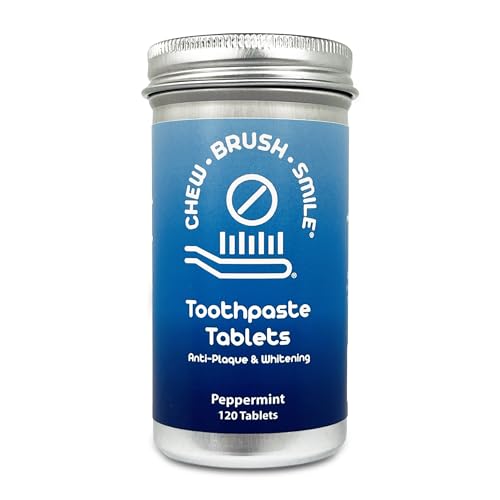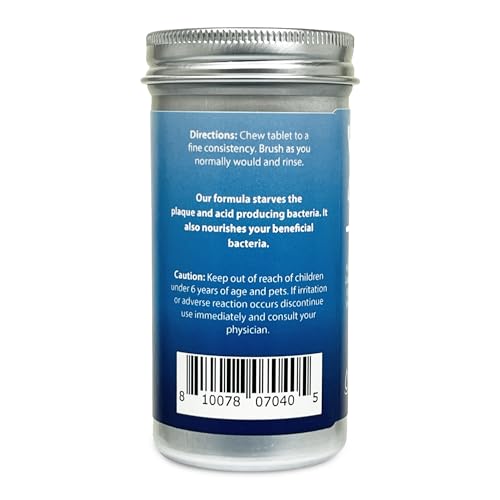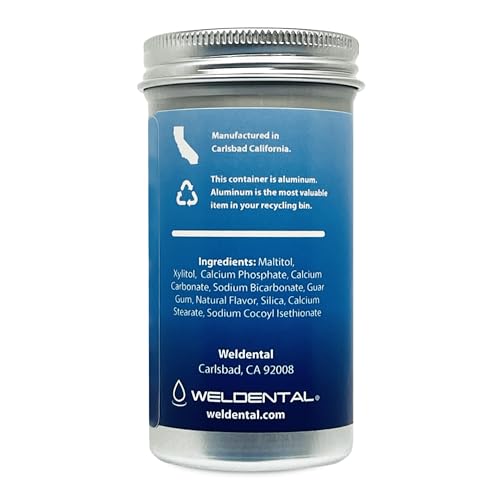


WELdental Chew Brush Smile Toothpaste Tablets - Anti-Plaque & Whitening, SLS-Free, 120 Count


Cyamopsis Tetragonoloba (Guar) Gum
Medium RiskCyamopsis tetragonoloba (guar) gum is a resinous substance derived from the seeds of the guar plant. It primarily functions as a thickening and stabilizing agent in various cosmetic and personal care products, enhancing texture and consistency.
Sustai Insights
Guar gum is valued for its thickening capabilities and is derived from a renewable source, contributing to its sustainability credentials. However, it poses moderate allergenic potential and low risks for carcinogenicity and reproductive toxicity. Environmental concerns are minimal, with no significant pollutant or bioaccumulation risks identified. Regulatory status is favorable, with no major restrictions noted. Users should practice caution with sensitive individuals, and alternatives like xanthan gum may serve as effective substitutes. Overall, the risk level associated with guar gum is assessed as medium, warranting careful consideration in product formulation.
Sand
Low RiskSand is loose, granular particles of worn or disintegrated rock, primarily composed of silica. It is commonly used as an abrasive, filler, or in construction and landscaping for its structural properties.
Sustai Insights
Sand offers functional benefits such as providing bulk and texture in various products, and it is generally considered to have low health risks, with minimal concerns regarding carcinogenicity, allergies, or reproductive toxicity. Environmentally, sand does not contribute significantly to pollution and is not bioaccumulative. Regulatory bodies do not impose restrictions on sand usage, maintaining its low-risk status. Safe usage practices should be followed to avoid inhalation of fine particles. Overall, sand is a low-risk ingredient with no notable negative impacts.
Maltitol
Low RiskMaltitol is a disaccharide polyol derived from the hydrogenation of maltose. It is commonly used as a sugar substitute in various food and cosmetic products due to its sweetness and lower caloric content compared to traditional sugars. Maltitol functions primarily as a humectant and sweetener.
Sustai Insights
Maltitol provides functional benefits as a sweetening agent with lower glycemic impact and is often used in sugar-free products. It is considered to have low health risks, including a low potential for carcinogenicity, allergy, and reproductive toxicity. Environmentally, it poses minimal risk as it is not bioaccumulative. Regulatory status is favorable, with no significant restrictions noted. Overall, maltitol is assessed as low risk, making it a suitable ingredient in appropriate concentrations.
Xylitol
Low RiskXylitol is a sugar alcohol used primarily as a sweetener. It is commonly found in oral care products and food items, offering a sweetening effect similar to sugar but with fewer calories. It serves as a humectant and can contribute to dental health by reducing the risk of cavities.
Sustai Insights
Xylitol provides functional benefits as a low-calorie sweetener and may help improve dental health by inhibiting cavity-causing bacteria. It is generally recognized as safe by the FDA with low concern for cancer, allergies, or reproductive toxicity. Environmental risks are minimal, as xylitol is biodegradable and does not accumulate in the ecosystem. Regulatory bodies have not imposed significant restrictions. Overall, xylitol presents a low risk when used appropriately, with no major adverse health effects reported and sustainable sourcing options available.
Sodium Cocoyl Isethionate
Low RiskSodium cocoyl isethionate is a surfactant derived from coconut oil, commonly used in cosmetic formulations. It functions as a cleansing and foaming agent, contributing to the texture and effectiveness of personal care products such as shampoos and body washes. It helps to remove dirt and oils from the skin and hair.
Sustai Insights
Sodium cocoyl isethionate offers functional benefits as a gentle surfactant that effectively cleanses without stripping moisture. It is biodegradable and derived from renewable sources, enhancing its sustainability profile. Health risks are low, with minimal potential for irritation or allergies noted. Regulatory bodies have not imposed significant restrictions, indicating a favorable risk assessment overall. Usage should be within recommended concentrations to maintain safety. Alternatives include milder surfactants like decyl glucoside for those seeking gentler options. Overall, the ingredient is assessed to have a low risk.
Calcium Stearate
Low RiskCalcium stearate is a calcium salt of stearic acid, primarily used as a lubricant and emulsifying agent in various products. It is commonly found in cosmetics, pharmaceuticals, and food applications, where it serves to enhance texture and stability.
Sustai Insights
Calcium stearate offers functional benefits as an effective emulsifier and stabilizer. It is generally recognized as safe by regulatory bodies, with low concerns regarding carcinogenicity, allergies, and reproductive toxicity. Environmental assessments indicate low pollutant potential and minimal bioaccumulation. Regulatory agencies have not imposed significant restrictions. Overall, the ingredient is considered low risk for health and environmental impacts, with safe usage practices recommended.
Calcite
Low RiskCalcite is a mineral primarily made up of calcium carbonate (CaCO3). It is commonly found in sedimentary rocks and is used in various applications, including construction, agriculture, and as a filler in products due to its whiteness and brightness.
Sustai Insights
Calcite offers functional benefits such as acting as a filler and providing opacity in products. It is sustainably sourced and biodegradable. Health risks are minimal, with low concerns regarding carcinogenicity, allergies, and reproductive toxicity. Environmental risks are also low, as calcite does not contribute significantly to pollution or bioaccumulation. Regulatory bodies do not impose restrictions on its use, affirming its safety. Overall, the risk level associated with calcite is low, making it a safe ingredient in various applications.
Sodium Bicarbonate
Low RiskSodium bicarbonate, commonly known as baking soda, is an inorganic compound with the formula NaHCO₃. It functions primarily as a leavening agent in baking, helping to produce carbon dioxide gas when it reacts with acids, thereby causing dough to rise. It also serves as a mild alkaline agent in various personal care products.
Sustai Insights
Sodium bicarbonate is valued for its effectiveness as a leavening agent and its role in neutralizing acidity, contributing to product stability. It is considered environmentally friendly and biodegradable. Health risks are minimal, with low concerns regarding carcinogenicity, allergies, and reproductive toxicity. It is not classified as a pollutant and poses no significant environmental hazards. Regulatory assessments indicate it is safe for use in food and cosmetic products. Overall, sodium bicarbonate carries a low risk, making it a practical choice in many applications.
Tricalcium Phosphate
Low RiskTricalcium phosphate is an inorganic salt composed of calcium and phosphate, commonly used as a dietary supplement and a food additive. It serves as a source of calcium, an anti-caking agent, and a filler in various products.
Sustai Insights
Tricalcium phosphate offers functional benefits as a calcium source, supporting bone health and serving as an effective anti-caking agent in food products. Its environmental impact is low, with no known pollutant potential or bioaccumulation concerns. Health risks are minimal, categorized as low for irritants and allergens, with no significant regulatory warnings. Overall, it presents a low-risk profile for consumers, making it a viable ingredient in various applications.
Sand
Low RiskSand is loose, granular particles of worn or disintegrated rock, primarily composed of silica. It is commonly used as an abrasive, filler, or in construction and landscaping for its structural properties.
Sustai Insights
Sand offers functional benefits such as providing bulk and texture in various products, and it is generally considered to have low health risks, with minimal concerns regarding carcinogenicity, allergies, or reproductive toxicity. Environmentally, sand does not contribute significantly to pollution and is not bioaccumulative. Regulatory bodies do not impose restrictions on sand usage, maintaining its low-risk status. Safe usage practices should be followed to avoid inhalation of fine particles. Overall, sand is a low-risk ingredient with no notable negative impacts.
Maltitol
Low RiskMaltitol is a disaccharide polyol derived from the hydrogenation of maltose. It is commonly used as a sugar substitute in various food and cosmetic products due to its sweetness and lower caloric content compared to traditional sugars. Maltitol functions primarily as a humectant and sweetener.
Sustai Insights
Maltitol provides functional benefits as a sweetening agent with lower glycemic impact and is often used in sugar-free products. It is considered to have low health risks, including a low potential for carcinogenicity, allergy, and reproductive toxicity. Environmentally, it poses minimal risk as it is not bioaccumulative. Regulatory status is favorable, with no significant restrictions noted. Overall, maltitol is assessed as low risk, making it a suitable ingredient in appropriate concentrations.
Xylitol
Low RiskXylitol is a sugar alcohol used primarily as a sweetener. It is commonly found in oral care products and food items, offering a sweetening effect similar to sugar but with fewer calories. It serves as a humectant and can contribute to dental health by reducing the risk of cavities.
Sustai Insights
Xylitol provides functional benefits as a low-calorie sweetener and may help improve dental health by inhibiting cavity-causing bacteria. It is generally recognized as safe by the FDA with low concern for cancer, allergies, or reproductive toxicity. Environmental risks are minimal, as xylitol is biodegradable and does not accumulate in the ecosystem. Regulatory bodies have not imposed significant restrictions. Overall, xylitol presents a low risk when used appropriately, with no major adverse health effects reported and sustainable sourcing options available.
Sodium Cocoyl Isethionate
Low RiskSodium cocoyl isethionate is a surfactant derived from coconut oil, commonly used in cosmetic formulations. It functions as a cleansing and foaming agent, contributing to the texture and effectiveness of personal care products such as shampoos and body washes. It helps to remove dirt and oils from the skin and hair.
Sustai Insights
Sodium cocoyl isethionate offers functional benefits as a gentle surfactant that effectively cleanses without stripping moisture. It is biodegradable and derived from renewable sources, enhancing its sustainability profile. Health risks are low, with minimal potential for irritation or allergies noted. Regulatory bodies have not imposed significant restrictions, indicating a favorable risk assessment overall. Usage should be within recommended concentrations to maintain safety. Alternatives include milder surfactants like decyl glucoside for those seeking gentler options. Overall, the ingredient is assessed to have a low risk.
Calcium Stearate
Low RiskCalcium stearate is a calcium salt of stearic acid, primarily used as a lubricant and emulsifying agent in various products. It is commonly found in cosmetics, pharmaceuticals, and food applications, where it serves to enhance texture and stability.
Sustai Insights
Calcium stearate offers functional benefits as an effective emulsifier and stabilizer. It is generally recognized as safe by regulatory bodies, with low concerns regarding carcinogenicity, allergies, and reproductive toxicity. Environmental assessments indicate low pollutant potential and minimal bioaccumulation. Regulatory agencies have not imposed significant restrictions. Overall, the ingredient is considered low risk for health and environmental impacts, with safe usage practices recommended.
Cyamopsis Tetragonoloba (Guar) Gum
Medium RiskCyamopsis tetragonoloba (guar) gum is a resinous substance derived from the seeds of the guar plant. It primarily functions as a thickening and stabilizing agent in various cosmetic and personal care products, enhancing texture and consistency.
Sustai Insights
Guar gum is valued for its thickening capabilities and is derived from a renewable source, contributing to its sustainability credentials. However, it poses moderate allergenic potential and low risks for carcinogenicity and reproductive toxicity. Environmental concerns are minimal, with no significant pollutant or bioaccumulation risks identified. Regulatory status is favorable, with no major restrictions noted. Users should practice caution with sensitive individuals, and alternatives like xanthan gum may serve as effective substitutes. Overall, the risk level associated with guar gum is assessed as medium, warranting careful consideration in product formulation.
Calcite
Low RiskCalcite is a mineral primarily made up of calcium carbonate (CaCO3). It is commonly found in sedimentary rocks and is used in various applications, including construction, agriculture, and as a filler in products due to its whiteness and brightness.
Sustai Insights
Calcite offers functional benefits such as acting as a filler and providing opacity in products. It is sustainably sourced and biodegradable. Health risks are minimal, with low concerns regarding carcinogenicity, allergies, and reproductive toxicity. Environmental risks are also low, as calcite does not contribute significantly to pollution or bioaccumulation. Regulatory bodies do not impose restrictions on its use, affirming its safety. Overall, the risk level associated with calcite is low, making it a safe ingredient in various applications.
Sodium Bicarbonate
Low RiskSodium bicarbonate, commonly known as baking soda, is an inorganic compound with the formula NaHCO₃. It functions primarily as a leavening agent in baking, helping to produce carbon dioxide gas when it reacts with acids, thereby causing dough to rise. It also serves as a mild alkaline agent in various personal care products.
Sustai Insights
Sodium bicarbonate is valued for its effectiveness as a leavening agent and its role in neutralizing acidity, contributing to product stability. It is considered environmentally friendly and biodegradable. Health risks are minimal, with low concerns regarding carcinogenicity, allergies, and reproductive toxicity. It is not classified as a pollutant and poses no significant environmental hazards. Regulatory assessments indicate it is safe for use in food and cosmetic products. Overall, sodium bicarbonate carries a low risk, making it a practical choice in many applications.
Tricalcium Phosphate
Low RiskTricalcium phosphate is an inorganic salt composed of calcium and phosphate, commonly used as a dietary supplement and a food additive. It serves as a source of calcium, an anti-caking agent, and a filler in various products.
Sustai Insights
Tricalcium phosphate offers functional benefits as a calcium source, supporting bone health and serving as an effective anti-caking agent in food products. Its environmental impact is low, with no known pollutant potential or bioaccumulation concerns. Health risks are minimal, categorized as low for irritants and allergens, with no significant regulatory warnings. Overall, it presents a low-risk profile for consumers, making it a viable ingredient in various applications.
Experience a revolutionary approach to oral care with WELdental Chew Brush Smile Toothpaste Tablets. Made in California, these peppermint-flavored tablets are not just eco-friendly but also effective in promoting dental health while being gentle on your mouth.
- Anti-Plaque & Whitening: These tablets help minimize plaque buildup and enhance the natural whiteness of your teeth, giving you a confident smile.
- SLS-Free Formula: Free from Sodium Lauryl Sulfate, these tablets are perfect for sensitive teeth, offering a gentle, irritation-free brushing experience.
- Eco-Conscious Packaging: The recyclable aluminum container not only protects the tablets but also contributes to a sustainable environment by reducing plastic waste.
- Natural Ingredients: Crafted with all-natural ingredients, including xylitol and calcium phosphate, these tablets ensure effective cleaning without harsh chemicals.
- Convenient & Cost-Effective: With 120 tablets per container, these toothpaste tablets are perfect for on-the-go lifestyles, making oral care easy and affordable.
Choose WELdental for a cleaner mouth, a brighter smile, and a healthier planet.
Subscribe & Save with Sustai
- Best Price Guarantee: Always enjoy the lowest prices on sustainable home essentials.
- No Surprises: We’ll notify you before shipping. No hidden fees, ever.
- You’re in Charge: Change, pause, or cancel your subscription anytime with ease.
- Eco-Friendly Deliveries: Our grouped shipments mean less packaging and lower emissions.
Join us on a sustainable journey. Special offers for a limited time! Prices and promotions may change.
Recommended Products
Experience a revolutionary approach to oral care with WELdental Chew Brush Smile Toothpaste Tablets. Made in California, these peppermint-flavored tablets are not just eco-friendly but also effective in promoting dental health while being gentle on your mouth.
- Anti-Plaque & Whitening: These tablets help minimize plaque buildup and enhance the natural whiteness of your teeth, giving you a confident smile.
- SLS-Free Formula: Free from Sodium Lauryl Sulfate, these tablets are perfect for sensitive teeth, offering a gentle, irritation-free brushing experience.
- Eco-Conscious Packaging: The recyclable aluminum container not only protects the tablets but also contributes to a sustainable environment by reducing plastic waste.
- Natural Ingredients: Crafted with all-natural ingredients, including xylitol and calcium phosphate, these tablets ensure effective cleaning without harsh chemicals.
- Convenient & Cost-Effective: With 120 tablets per container, these toothpaste tablets are perfect for on-the-go lifestyles, making oral care easy and affordable.
Choose WELdental for a cleaner mouth, a brighter smile, and a healthier planet.

You can have at most 2 Sustainable Steals products in your cart
Customer Reviews
Customers’ View
Customers appreciate the effectiveness and convenience of WELdental Chew Brush Smile Toothpaste Tablets, particularly noting their refreshing minty taste and effectiveness in maintaining oral cleanliness. Many users highlight the product's ease of use, emphasizing how it eliminates the mess associated with traditional toothpaste tubes, making it an excellent choice for travel. The foaming ability of the tablets has also received positive feedback, with customers finding it adequate for a thorough clean. Additionally, the fluoride-free and SLS-free formulation aligns well with the preferences of health-conscious consumers. Overall, customers find this product both effective and well-suited to their eco-friendly lifestyles, particularly due to its recyclable packaging.
AI-generated from the text of customer reviewsThis product is rated 4.5 of 5.0 stars.
It has received 23 reviews.




